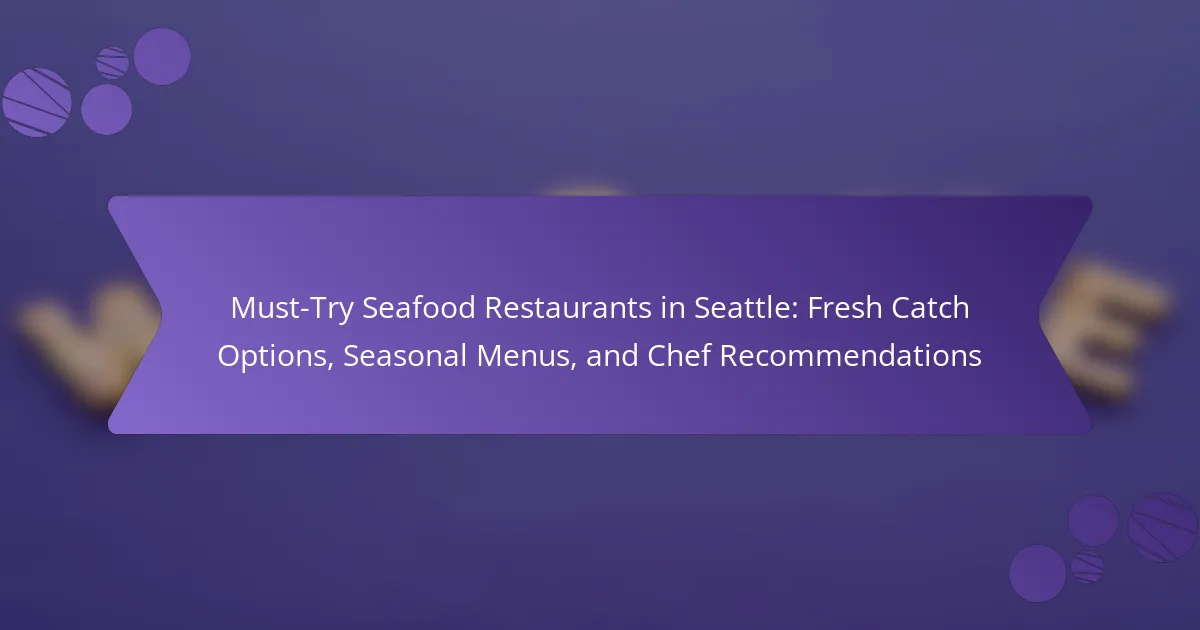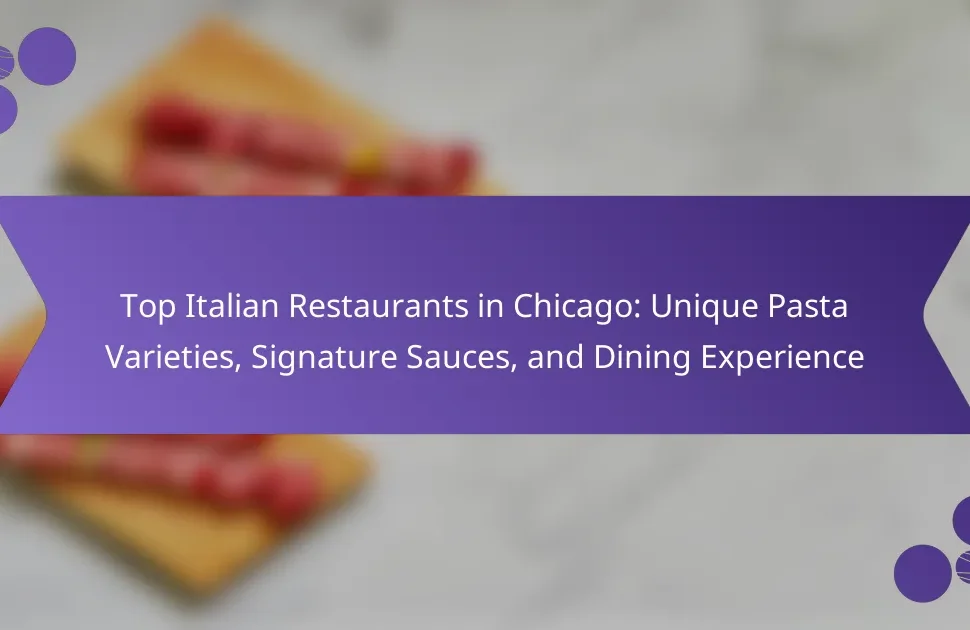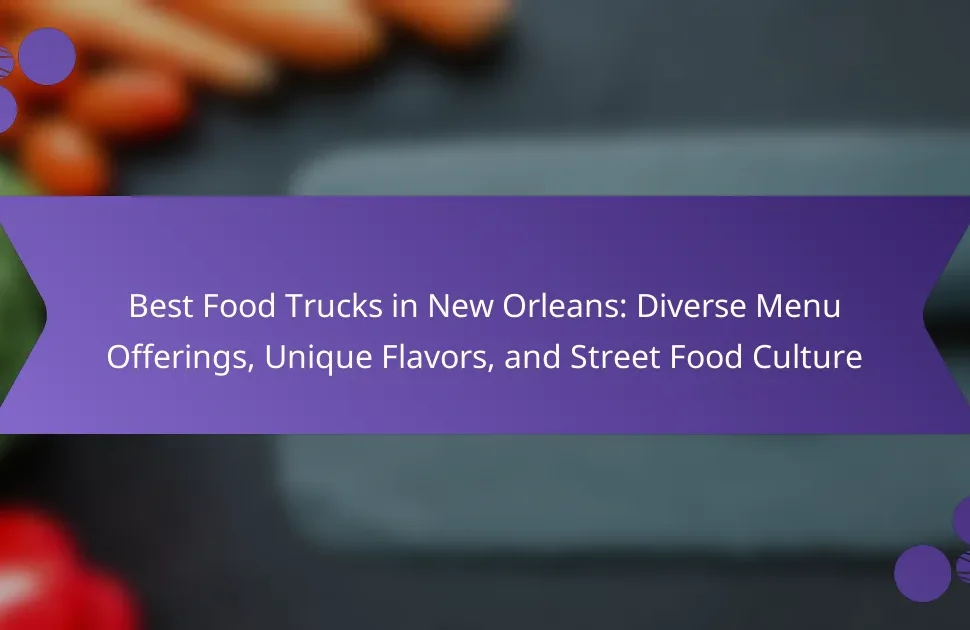
What are the Must-Try Seafood Restaurants in Seattle?
The must-try seafood restaurants in Seattle include Pike Place Chowder, known for its award-winning clam chowder. The Crab Pot offers a unique dining experience with seafood boils. Canlis is an upscale restaurant featuring Pacific Northwest cuisine with fresh seafood options. Ivar’s Acres of Clams serves traditional dishes with a waterfront view. The Walrus and the Carpenter is famous for its oysters and small plates. These restaurants are celebrated for their quality, freshness, and unique offerings, making them essential stops for seafood lovers in Seattle.
How do these restaurants stand out in the Seattle dining scene?
These restaurants stand out in the Seattle dining scene through their focus on fresh, locally sourced seafood. They offer unique seasonal menus that highlight the region’s best catches. Many feature signature dishes that reflect the culinary creativity of their chefs. The ambiance often combines a coastal aesthetic with a warm, inviting atmosphere. Additionally, these restaurants prioritize sustainability in their sourcing practices. They frequently collaborate with local fishermen and fisheries to ensure quality. Many have received accolades from food critics and local awards, reinforcing their reputation. Overall, their commitment to quality and innovation sets them apart.
What unique dining experiences do these restaurants offer?
Unique dining experiences at seafood restaurants in Seattle include waterfront views, interactive chef tables, and seasonal tasting menus. Many establishments offer fresh catch options sourced daily from local fisheries. Some restaurants feature sustainable seafood practices, enhancing the dining experience. Guests can enjoy live cooking demonstrations, which add an engaging element to their meal. Certain venues provide private dining rooms for intimate gatherings. Others host themed nights, such as oyster tastings or crab feasts, creating a festive atmosphere. The combination of fresh ingredients and innovative culinary techniques makes each visit memorable. These unique offerings contribute to Seattle’s reputation as a seafood dining destination.
How do the locations of these restaurants enhance the seafood experience?
The locations of these restaurants enhance the seafood experience by providing access to fresh, local catches. Proximity to the ocean ensures that seafood is delivered quickly, maintaining its quality and flavor. Restaurants situated near waterfronts often offer scenic views, creating a more enjoyable dining atmosphere. Many of these locations also feature outdoor seating, allowing diners to enjoy the fresh sea breeze. Additionally, local markets nearby can supply seasonal ingredients, enhancing menu variety. This connection to the region’s fishing culture enriches the overall dining experience. Freshness and locality are key factors in seafood quality, making these locations ideal for seafood enthusiasts.
What types of seafood can you expect at these restaurants?
At these seafood restaurants, you can expect a variety of fresh seafood options. Common offerings include salmon, halibut, and Dungeness crab. Many restaurants also serve shellfish like oysters, clams, and shrimp. Seasonal menus may feature unique catches such as spot prawns or rockfish. Some establishments specialize in local varieties sourced directly from the Pacific Northwest. The seafood is often prepared using regional cooking styles and ingredients. This ensures a fresh and flavorful dining experience. Many of these restaurants prioritize sustainability in their seafood sourcing practices.
What are the most popular seafood dishes served?
The most popular seafood dishes served include clam chowder, fish and chips, and salmon. Clam chowder is a creamy soup made with clams, potatoes, and onions. Fish and chips consist of battered and fried fish served with fries. Salmon, often grilled or smoked, is a staple in many seafood restaurants. Other popular dishes include shrimp scampi, crab cakes, and oysters on the half shell. Shrimp scampi features shrimp sautéed in garlic and butter. Crab cakes are made from lump crab meat mixed with breadcrumbs and spices. Oysters on the half shell are served raw and are a delicacy in many coastal areas. These dishes reflect the diverse seafood offerings available in Seattle’s culinary scene.
How do seasonal offerings influence the menu options?
Seasonal offerings significantly influence menu options by aligning dishes with the availability of fresh ingredients. Restaurants often adjust their menus to highlight seafood that is in season. This practice ensures optimal flavor and quality in the dishes served. For example, certain fish may only be available during specific months, prompting chefs to create unique recipes around those catches. Additionally, seasonal offerings can attract customers seeking fresh, local experiences. Research shows that menu items featuring seasonal ingredients can increase customer satisfaction and repeat visits. According to a 2021 study by the National Restaurant Association, 70% of diners prefer restaurants that use seasonal ingredients. This trend encourages chefs to innovate and adapt their menus frequently.
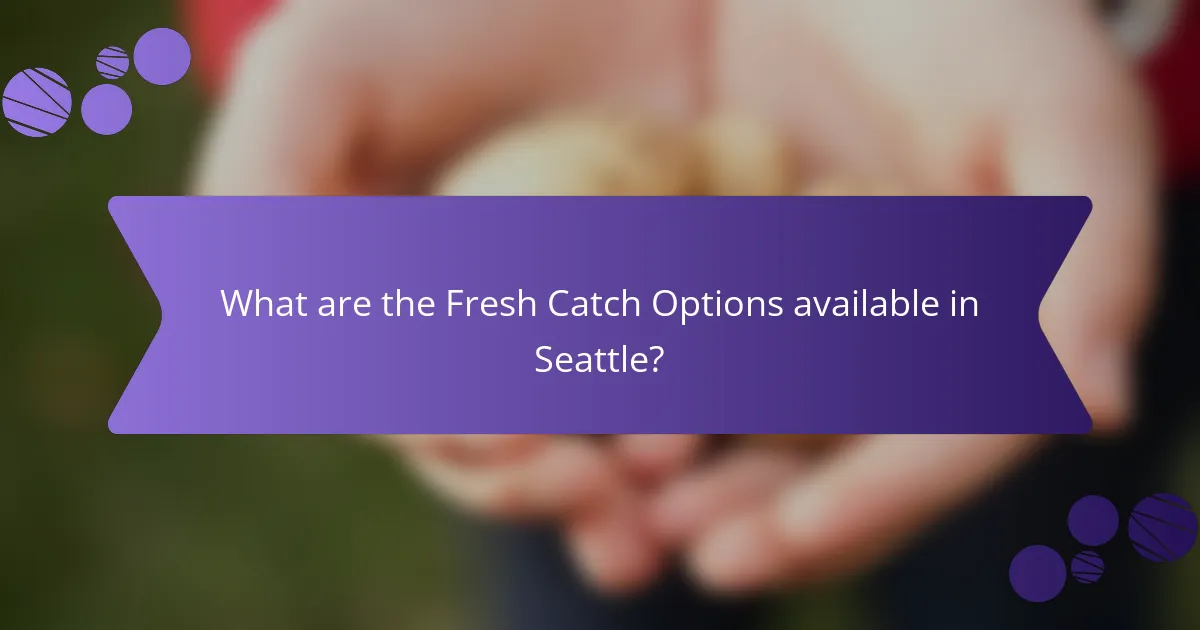
What are the Fresh Catch Options available in Seattle?
Fresh catch options available in Seattle include salmon, halibut, and Dungeness crab. These seafood choices are sourced locally and reflect the region’s rich maritime heritage. Salmon, particularly Chinook and Coho, are popular for their flavor and are often featured on restaurant menus. Halibut is known for its firm texture and mild taste, making it a versatile choice for various dishes. Dungeness crab is celebrated for its sweet meat and is typically served steamed or in crab cakes. Seasonal availability may vary, but these options are consistently highlighted in Seattle’s seafood offerings.
How do restaurants source their seafood for freshness?
Restaurants source their seafood for freshness through direct relationships with local fishermen and suppliers. They often prioritize sustainable fishing practices to ensure quality. Many restaurants conduct regular deliveries to maintain optimal freshness. Some establishments even have their own fishing boats or partnerships with local fisheries. Additionally, restaurants may participate in seafood auctions for the freshest catch. They also verify the sourcing standards of their suppliers. Traceability is key; restaurants often track the origin of their seafood. This commitment to sourcing helps guarantee high-quality dishes for customers.
What local fisheries contribute to the seafood supply?
Local fisheries that contribute to the seafood supply in Seattle include the Puget Sound fisheries and the Columbia River fisheries. Puget Sound fisheries are known for their diverse species such as salmon, halibut, and shellfish. The Columbia River fisheries provide significant amounts of salmon, sturgeon, and other freshwater fish. These fisheries support local restaurants and markets with fresh seafood. According to the Washington Department of Fish and Wildlife, these fisheries are vital for both commercial and recreational fishing in the region.
How does the catch of the day impact menu offerings?
The catch of the day significantly impacts menu offerings by introducing fresh, seasonal seafood options. Restaurants often adjust their menus based on daily catches to ensure quality and freshness. This practice enhances customer experience by providing unique dishes that reflect local availability. Seasonal seafood can include varieties like salmon, halibut, or shellfish, which may not be available year-round. By featuring the catch of the day, chefs can showcase their creativity and culinary skills. This approach also supports local fishermen and promotes sustainable fishing practices. Many seafood restaurants in Seattle highlight the catch of the day to attract diners seeking authentic and fresh dining experiences.
What are the benefits of choosing fresh seafood?
Choosing fresh seafood offers numerous health benefits. Fresh seafood is typically rich in omega-3 fatty acids, which are essential for heart health. It also contains high-quality protein, necessary for muscle repair and growth. Fresh seafood is lower in saturated fats compared to red meats, promoting better cholesterol levels. Additionally, it is a great source of vitamins and minerals, including vitamin D and selenium. Studies indicate that regular consumption of seafood can reduce the risk of chronic diseases. The nutritional profile of fresh seafood can enhance overall well-being and support a balanced diet.
How does fresh seafood enhance flavor and nutrition?
Fresh seafood enhances flavor and nutrition through its natural taste and rich nutrient profile. The ocean provides seafood with a unique umami flavor that is often more pronounced than land-based proteins. Fresh seafood is typically high in omega-3 fatty acids, which are essential for heart health. Studies show that omega-3s can reduce inflammation and lower the risk of chronic diseases. Additionally, seafood is a good source of lean protein, which supports muscle health and weight management. Fresh varieties retain more vitamins and minerals, such as vitamin D and selenium, compared to processed options. Eating fresh seafood can also improve overall dietary diversity, contributing to better health outcomes.
What impact does fresh seafood have on sustainability?
Fresh seafood can have both positive and negative impacts on sustainability. Sustainable seafood practices promote healthy fish populations and ecosystems. Overfishing threatens marine biodiversity and depletes fish stocks. According to the Marine Stewardship Council, sustainable fisheries are managed to maintain fish populations at healthy levels. Responsible sourcing of fresh seafood helps reduce environmental harm. Additionally, local sourcing minimizes carbon footprints associated with transportation. In contrast, unsustainable seafood practices can lead to habitat destruction and bycatch of non-target species. Thus, the impact of fresh seafood on sustainability largely depends on sourcing methods and management practices.
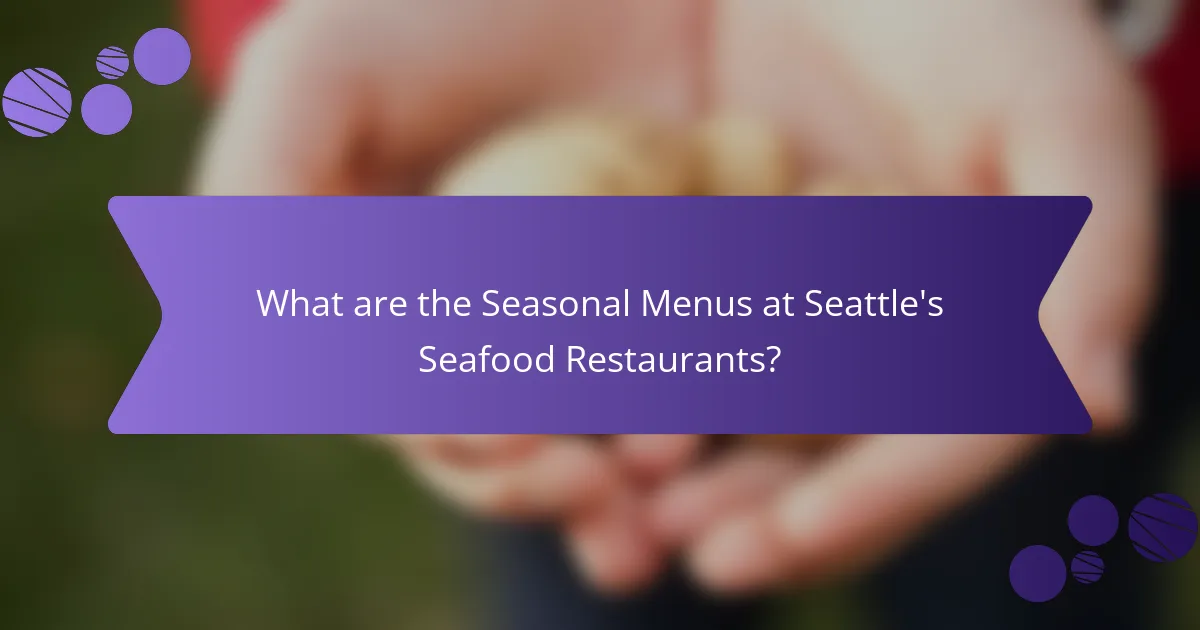
What are the Seasonal Menus at Seattle’s Seafood Restaurants?
Seasonal menus at Seattle’s seafood restaurants feature dishes that highlight the freshest local catches available throughout the year. These menus change based on the availability of fish and shellfish, ensuring optimal flavor and sustainability. For instance, spring may showcase Dungeness crab and halibut, while summer often includes salmon and shellfish like geoduck. Fall menus frequently highlight Pacific rockfish and spot prawns, and winter might focus on cod and clams. Many restaurants emphasize sourcing from local fisheries to support sustainability. Specific restaurants, such as Canlis and The Walrus and the Carpenter, are known for their seasonal offerings that reflect the best of the Pacific Northwest’s seafood bounty.
How do seasonal changes affect the seafood offerings?
Seasonal changes significantly impact seafood offerings. Different species of fish and shellfish are available at various times of the year. For example, salmon is primarily caught in the summer months. In contrast, winter brings an abundance of shellfish like crab and oysters. Local regulations also influence the availability of certain species based on spawning seasons. Restaurants adjust their menus to reflect these seasonal changes. They often highlight fresh, locally sourced seafood. This practice ensures that diners experience the best flavors of the season. Additionally, seasonal offerings can enhance sustainability by promoting responsible fishing practices.
What seasonal ingredients are typically featured?
Seasonal ingredients typically featured in Seattle seafood restaurants include fresh fish, shellfish, and local produce. Salmon is a prominent fish, especially during the summer months. Dungeness crab is often highlighted in winter and spring menus. Seasonal vegetables like asparagus and heirloom tomatoes complement seafood dishes. Additionally, foraged ingredients like wild mushrooms and seaweed are commonly used. Local farms provide fresh herbs and greens, enhancing the flavors of seafood preparations. These ingredients reflect the Pacific Northwest’s culinary landscape and its focus on sustainability.
How do chefs create seasonal dishes that highlight local seafood?
Chefs create seasonal dishes that highlight local seafood by sourcing fresh ingredients from nearby waters. They often collaborate with local fishermen to ensure the seafood is at its peak quality. Seasonal menus reflect the availability of different seafood types throughout the year. For example, chefs may feature salmon in summer and shellfish in winter. They also consider sustainability practices when selecting seafood. This approach supports local economies and reduces the carbon footprint associated with transportation. Seasonal dishes often incorporate regional flavors and ingredients to enhance the seafood. Chefs may use herbs, spices, and vegetables that are in season to complement the seafood offerings.
What are some chef recommendations for seasonal dining?
Chefs recommend focusing on locally sourced ingredients for seasonal dining. Seasonal menus highlight the freshest produce and seafood available. For spring, dishes featuring asparagus and halibut are popular. In summer, tomatoes and salmon take center stage. Fall brings flavors like pumpkin and Dungeness crab. Winter menus often include root vegetables and shellfish. Using seasonal ingredients enhances flavor and supports local farmers. This practice also aligns with sustainable dining trends.
Which dishes do chefs recommend for first-time visitors?
Chefs recommend the clam chowder and Dungeness crab for first-time visitors. Clam chowder is a creamy soup rich in flavor and a local favorite. Dungeness crab is known for its sweet, tender meat and is often served steamed or in a salad. Additionally, salmon dishes, particularly the grilled or smoked varieties, highlight the region’s fresh catch. Oysters, served raw or grilled, are also a must-try for their briny taste. These dishes reflect the essence of Seattle’s seafood culture and showcase the city’s culinary strengths.
How can diners best experience the seasonal menu?
Diners can best experience the seasonal menu by ordering dishes that highlight fresh, local ingredients. Seasonal menus often change based on availability, ensuring the use of peak produce and seafood. Engaging with the server for recommendations enhances the dining experience. Servers typically have insights into the most popular or unique offerings. Pairing seasonal dishes with appropriate beverages can elevate flavors. Many restaurants offer curated wine or cocktail pairings to complement seasonal items. Diners should also consider sharing plates to sample a variety of flavors. This approach allows for a broader tasting experience of the menu. Lastly, visiting during peak season for specific ingredients ensures the best quality and taste.
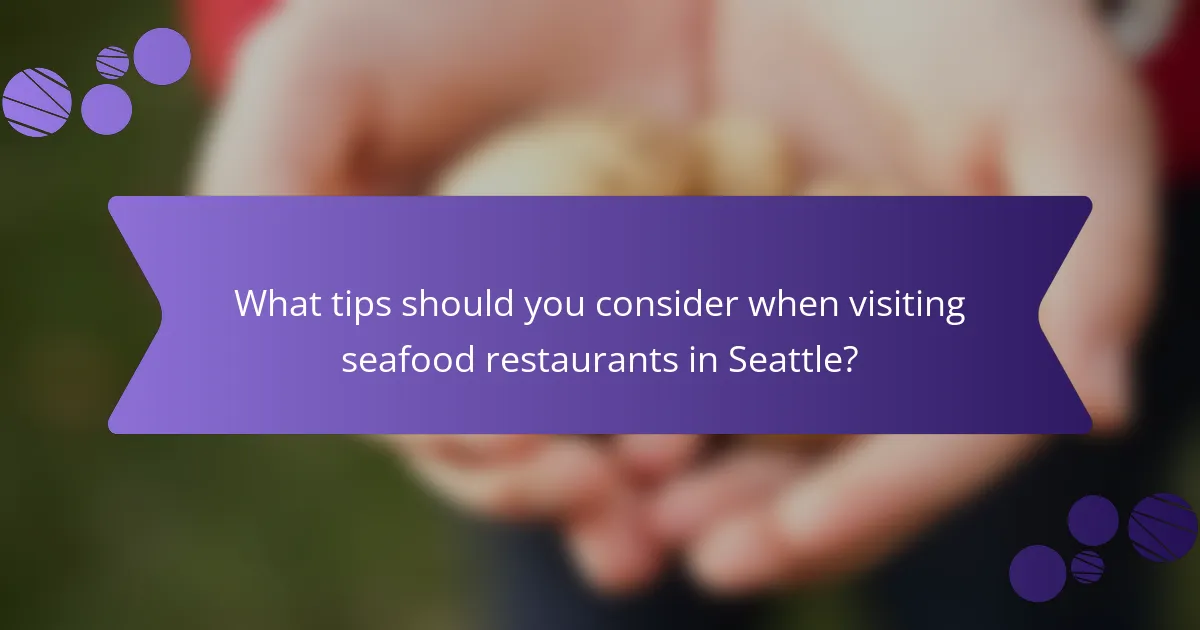
What tips should you consider when visiting seafood restaurants in Seattle?
When visiting seafood restaurants in Seattle, prioritize freshness. Look for restaurants that source seafood from local fisheries. Check menus for seasonal offerings, as they often feature the freshest ingredients. Consider dining during off-peak hours for better service and availability. Ask staff for recommendations on daily specials or chef’s favorites. Familiarize yourself with popular local dishes, such as Dungeness crab or salmon. Pay attention to sustainability practices, as many Seattle restaurants emphasize eco-friendly sourcing. Lastly, read reviews to gauge the quality and reputation of the restaurant.
How can you ensure a great dining experience?
To ensure a great dining experience, focus on quality food, attentive service, and a pleasant atmosphere. Quality food means using fresh, seasonal ingredients. Seafood restaurants in Seattle often highlight local catches to enhance flavor. Attentive service includes knowledgeable staff who can recommend dishes and pairings. A pleasant atmosphere involves comfortable seating and appropriate lighting. Research shows that ambiance significantly impacts diners’ satisfaction. According to a study by the Cornell University School of Hotel Administration, a welcoming environment improves overall dining experiences.
What are the best times to visit for optimal freshness?
The best times to visit seafood restaurants in Seattle for optimal freshness are during the morning hours and early afternoon. Seafood is typically delivered fresh in the early morning. Many restaurants prepare their dishes right after receiving deliveries. Visiting during lunch hours can ensure you experience the freshest options available. Peak freshness is often seen on weekdays, especially Tuesday through Thursday. This is when restaurants have the least turnover and can maintain their stock better. Seasonal variations also affect freshness; spring and summer months often yield the best catches. Local fisheries are more active during these times, contributing to higher quality seafood.
How can you pair wine or drinks with seafood dishes effectively?
Pairing wine or drinks with seafood dishes effectively involves understanding flavor profiles. White wines, such as Sauvignon Blanc, complement light seafood like shrimp and scallops. These wines enhance the dish without overpowering it. For richer seafood, like salmon, consider a Pinot Noir. Its fruitiness balances the dish’s oiliness. Sparkling wines, like Champagne, pair well with fried seafood due to their acidity. This acidity cuts through the fat, refreshing the palate. Additionally, consider the preparation method. Grilled seafood pairs nicely with oaked Chardonnay. The wine’s buttery notes match the charred flavors. Always consider local seafood varieties available in Seattle, as they may suggest specific pairings.
Must-Try Seafood Restaurants in Seattle highlight the city’s best seafood dining experiences, featuring renowned establishments such as Pike Place Chowder, The Crab Pot, and Canlis. The article covers the unique attributes of these restaurants, including their commitment to fresh, locally sourced seafood and seasonal menus that reflect the region’s culinary landscape. It also discusses popular seafood dishes, the influence of seasonal offerings on menu options, and tips for diners to enhance their experience, ensuring they savor the best of Seattle’s seafood culture. Additionally, the article emphasizes the importance of sustainability and local sourcing in the seafood dining scene.
